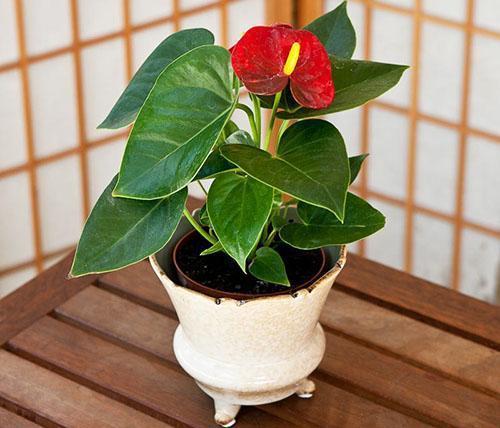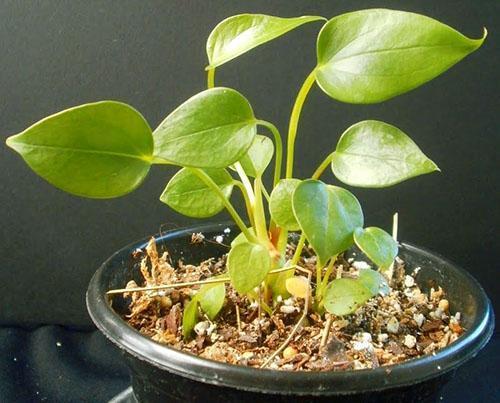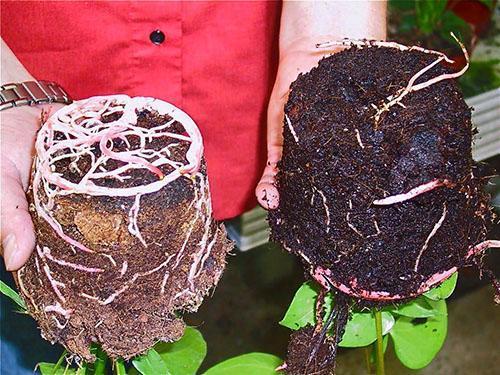Features of the methods of carrying out anthurium transplantation
 Anthurium is popularly called a flamingo flower. And this comparison is quite justified. Graceful inflorescences on long peduncles really look like exotic birds and leave no one indifferent. Plants with decorative leaves of all shapes, sizes and colors are no less interesting than the flowering varieties of anthurium.
Anthurium is popularly called a flamingo flower. And this comparison is quite justified. Graceful inflorescences on long peduncles really look like exotic birds and leave no one indifferent. Plants with decorative leaves of all shapes, sizes and colors are no less interesting than the flowering varieties of anthurium.
In South America, which is the birthplace of anthurium, these plants most often grow as epiphytes, mastering the upper levels of tropical forests, growing on the roots, tree branches and below, under the crowns. Here, the root system of plants, which form powerful underground and aerial roots, is not held back, and anthuriums reproduce and bloom perfectly even without transplantation.
At home, anthuriums do not have the opportunity to lead a familiar lifestyle, and pots on the windowsills become their habitat. In order for the plants here to please with spectacular flowering, green pets must not only be carefully looked after, but also transplanted from time to time.
How is anthurium transplant going at home? And how to determine that the plant really needs this procedure?
Anthurium transplantation methods

- the development of the entire earthen coma by the roots and the obvious crampedness of the old pot;
- improperly selected soil mixture, which negatively affects the state of the plant and its development;
- disease of the root system and the appearance of traces of rot on it.
Depending on what caused it, transplanting anthurium at home may represent its transfer into a new pot with a small amount of substrate renewal, or the plant is transferred, having previously cleared of traces of old soil.
Adult healthy plants, actively blooming and not showing external signs of disease, are transferred to a larger pot every 2-3 years.
The need for such a procedure is indicated by thick roots that have emerged from the drainage holes and above the soil surface. Not finding free space inside the container, the roots go out, trying to get food and moisture from the air.
In order not to damage the root system during anthurium transplantation, the plant is watered abundantly before the procedure. This softens the soil and makes it easier to remove the clod from the pot. If the pot is made of plastic, you can wrinkle it slightly or knock it on the edge of the table. Then the anthurium is removed and, after examining the roots, is transferred to a new pot, where there is already a good drainage layer, and a layer of substrate is poured over it.
 The plant after transplanting will soon bloom, if the new pot is not much larger than the previous one. It is better to give preference to containers in which the height is equal to the diameter. Having transplanted anthurium into an overly spacious pot, the florist dooms himself to a long wait for bright inflorescences. Until the roots grow into new soil, the anthurium will not form flower buds.
The plant after transplanting will soon bloom, if the new pot is not much larger than the previous one. It is better to give preference to containers in which the height is equal to the diameter. Having transplanted anthurium into an overly spacious pot, the florist dooms himself to a long wait for bright inflorescences. Until the roots grow into new soil, the anthurium will not form flower buds.
An earthen lump, braided by roots, is placed in the center of the pot, and the gaps formed on the sides are filled with fresh substrate.
The soil should be slightly compacted, trying not to touch or deform the rhizomes. The top layer is also renewed, then the plantings, if necessary, are watered again, and the surface of the soil is covered with sphagnum to preserve moisture.
After transplanting, the anthurium acclimatizes quite quickly, and soon you can expect the appearance of new foliage and inflorescences.
A different procedure is for the plant if the grower has doubts about his condition and health. A common cause for concern is:
- the appearance of spots on stems and leaves;
- wilting of foliage and loss of its usual tone;
- refusal of flowering and growth retardation.
Unfortunately, after the purchase, anthuriums also have to be transplanted, otherwise the plant quickly weakens and may die.
 Urgently transplant anthurium, as in the photo, which is rapidly losing its attractiveness and even after watering does not restore the elasticity and vertical position of the petioles and peduncles. The plant can suffer both from the abundance of moisture in the soil, its poverty or excessive density, as well as from the actions of pests, disease or putrefactive bacteria.
Urgently transplant anthurium, as in the photo, which is rapidly losing its attractiveness and even after watering does not restore the elasticity and vertical position of the petioles and peduncles. The plant can suffer both from the abundance of moisture in the soil, its poverty or excessive density, as well as from the actions of pests, disease or putrefactive bacteria.
In all these cases, one cannot hesitate. Anthurium is watered and, as already described, removed from the pot. In contrast to the situation when anthurium is transplanted without signs of disease, here, if possible, it is necessary to remove the old soil, protecting the roots and examining them along the way.
If the roots of the plant are damaged or rotted, such areas are carefully trimmed to a healthy white tissue, treating the sections with charcoal or activated carbon powder.
 The green part of the anthurium is also freed from dry or lost leaves; the existing inflorescences should be cut off along with the peduncles. This measure will reduce the stress on the weakened plant and help it overcome the shock of the transplant faster. For insurance, it is better to treat a plant with traces of rot with a fungicide.
The green part of the anthurium is also freed from dry or lost leaves; the existing inflorescences should be cut off along with the peduncles. This measure will reduce the stress on the weakened plant and help it overcome the shock of the transplant faster. For insurance, it is better to treat a plant with traces of rot with a fungicide.
After transplantation of anthurium that has undergone late blight, root rot or other disease, the florist should carefully monitor the condition of such a plant, and, if necessary, re-process the crown, soil and root system.
If you have to transplant a plant into the same pot or use a container that has already served as a refuge for another culture, they must be treated with boiling water or a solution of potassium permanganate.
Anthurium transplant soil
 The peculiarity of anthuriums is that plants can feel good only in a very loose, lightweight substrate. The best soil for this tropical dweller is one that is water permeable and provides easy access for oxygen. After transplanting anthurium into a suitable substrate, its roots easily penetrate into the soil, easily obtaining the necessary nutrition and moisture. If the florist is mistaken with the choice of soil for anthurium, this will soon affect the plant, its growth, decorativeness and health.
The peculiarity of anthuriums is that plants can feel good only in a very loose, lightweight substrate. The best soil for this tropical dweller is one that is water permeable and provides easy access for oxygen. After transplanting anthurium into a suitable substrate, its roots easily penetrate into the soil, easily obtaining the necessary nutrition and moisture. If the florist is mistaken with the choice of soil for anthurium, this will soon affect the plant, its growth, decorativeness and health.
There are many recipes for compiling a soil mixture for anthuriums. At the heart of the substrate can be either a ready-made mixture for orchids, to which crushed charcoal and a little sod land are mixed, or self-made soil. It is often recommended for anthuriums in equal parts to mix crushed sphagnum, peat and coconut fiber. There is also a ready-made specialized substrate for anthuriums and other aroid species.
When it is not possible to find certain components, for transplanting anthurium, you can take the topsoil from the coniferous forest.
True, such natural raw materials require the most thorough disinfection in order to exclude the danger of plant infection with soil pests and fungi.
When and how to transplant anthurium after purchase
 If the planned transplant of anthurium most often takes place at the end of winter or in the first weeks of spring, then a copy purchased in a store is best transplanted shortly after entering the house. The fact is that anthuriums intended for sale are planted in pots with a small amount of peat or coconut substrate filled with prolonged-release fertilizers.
If the planned transplant of anthurium most often takes place at the end of winter or in the first weeks of spring, then a copy purchased in a store is best transplanted shortly after entering the house. The fact is that anthuriums intended for sale are planted in pots with a small amount of peat or coconut substrate filled with prolonged-release fertilizers.
The supply of such an anthurium is designed for a month or two.Plants actively blooming on the shelves by the time they enter the house spend their last strength and may die if they are not transplanted into fresh soil.
In this regard, the question arises: "How to transplant anthurium after purchase, if the plant is still in bloom?" Indeed, is it worth worrying about such a specimen?
 It is worth transferring such a plant to a nutritious full-fledged soil, and before removing it from the pot, you need to cut off all the peduncles. A simple trick will facilitate the acclimatization of the anthurium after transplantation, and bright inflorescences will not disappear. If they are cut when the pollen has already showered the ear, the inflorescences in the vase will decorate the house for more than a month.
It is worth transferring such a plant to a nutritious full-fledged soil, and before removing it from the pot, you need to cut off all the peduncles. A simple trick will facilitate the acclimatization of the anthurium after transplantation, and bright inflorescences will not disappear. If they are cut when the pollen has already showered the ear, the inflorescences in the vase will decorate the house for more than a month.
A video about the transplant of anthurium will tell you in detail about this important procedure and will help you in practice to master its most difficult stages.
Anthurium care after transplant
 Until the top layer of the substrate under the plant dries out, anthurium should not be watered after transplanting. In addition, a pet who has experienced a serious shock must be carefully protected from drafts and direct sunlight.
Until the top layer of the substrate under the plant dries out, anthurium should not be watered after transplanting. In addition, a pet who has experienced a serious shock must be carefully protected from drafts and direct sunlight.
Since the plant has received everything it needs for growth, and its roots need time to acclimatize, it is not necessary to feed anthurium for another 2-3 months after transplantation.
If you neglect this advice, organic and mineral substances trapped in the soil can cause a burn of damaged tissues and only prolong the discomfort undesirable for the plant.
An anthurium transplant at home can be used to separate the mother plant and obtain several young cuttings. To do this, lateral shoots that have acquired roots are carefully separated and transferred to separate small pots.
Such measures as in the video, except that they are applied to a sick plant, with rotten roots. But in order to climb into the root, injure completely healthy roots in a healthy plant as a result…. no words….
Hello! Please tell me what to do - my anthurium itself does not hold (falls on its side) without a support.
You can, of course, stick a stick into the pot for support ... But what if the reason is hidden deeper? I would check why the bush suddenly lost its stability. After all, a healthy antruium has a good turgor, its petioles are straight, the leaves look up, and the rosette is all "in a bunch". Check the roots, they may have rotted and can no longer hold the bush.